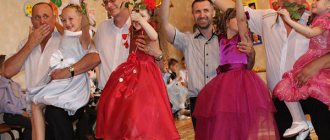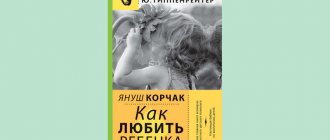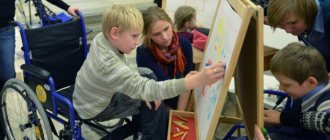Weekend route" as a way of effective interaction between family and preschool educational institution project on the topic
Parent education
“Weekend route” as a way to effectively
interaction between family and preschool educational institution.
Topic: “Walk with interest” - Museum of Moscow with a new interactive program for children of senior preschool age “Once upon a time there were Muscovites.”
Compiled and prepared by: senior teacher Deeva T.S.
“Weekend route” as a way of effective interaction between family and preschool educational institution. One of the priority areas of the preschool educational institution’s work is interaction with parents. Preschool teachers are searching for innovative forms and methods of working with parents of pupils to establish positive interaction and cooperation within the framework of the education of preschool children. One effective way to work is to develop “weekend routes”. A “weekend route” can be developed for children of all ages. The age of the child determines the specifics of the route.
The purpose of developing a “weekend route”:
Cultivating in preschoolers respect and interest in their native land, human spiritual culture through the interaction and cooperation of teachers with parents.
Route development algorithm:
— Collecting information about the place of visit, the upcoming cultural event in the life of the city via the Internet, telephone communication, personal visit.
— Collection of information about the necessary equipment and visiting conditions.
— Development of a route indicating the main attractions that should be focused on by the child. Compiling a newsletter for parents.
— Presentation of the newsletter for parents and children.
Getting feedback:
— Organizing a morning meeting in the group on Monday, sharing impressions, showing children programs, photographs, booklets from the place of visit.
— Listening to children’s mini-messages about the place of visit based on the model.
— Registration of the results of the visit in the form of photo reports, exhibitions, presentations.
Result:
Motivating parents for upcoming joint activities and further cooperation with the kindergarten. Expanding children's ideas about their hometown and region. Expansion of children's active and passive vocabulary, development of coherent speech. Saturation of the subject-spatial environment with local history materials: albums, photo exhibitions, vernissages of drawings created by children together with their parents, presentations about the city and the region.
An example of a “weekend route” for senior and preparatory groups of preschool educational institutions, as well as for “family kindergartens”:
Dear moms and dads!
The happiest day is a day off when the whole family gets together! The weekend is already a holiday.
And a weekend spent with children is a double holiday!
And to make this holiday bright and unforgettable, we bring to your attention the “Weekend Route”
on the topic: “Walk with interest.”
The Museum of Moscow with a new interactive program for children of senior preschool age “Once upon a time there were Muscovites.”
The museum is open from 10.00 to 20.00, closed on Monday, every third Sunday of the month - admission is free;
The Museum of Moscow is located at: Zubovsky Boulevard, building 2;
nearest metro station "Park Kultury";
Phone:+7.
The Museum of Moscow has launched a new series of interactive programs, including the program “Once upon a time there were Muscovites.” The interactive program “Once upon a time there were Muscovites” is taking place at the exhibition “History of Moscow for Children and Adults.”
Program participants will visit a Moscow house of the 16th century. They will learn how the house was built, what parts it consisted of, how the rooms were used, and what furniture was in them. Sitting at a large table in the red corner, the children will learn how to follow the rules of a medieval meal and how to use cutlery. They will learn how responsibilities were distributed among family members, and test their strength and dexterity by performing household chores of medieval Muscovites.
The children will be told about the “magic” of the most ordinary household items. After all, a medieval housewife could use a sieve to make it rain, and use a broom to cast out evil spirits. Program participants will also learn to play ancient games. The children will be able to travel back in time with clothes made from medieval costumes and headdresses of medieval Muscovites.
The program is designed for preschool children (4–6 years old).
We wish you a pleasant cultural holiday!
Photo “Weekend route” Museum of Moscow, November 2021
“Weekend route” as a way of effective interaction between family and preschool educational institution.”
Topic: “Walk with interest” - Museum of Moscow with a new interactive program for children of senior preschool age “Once upon a time there were Muscovites.”
Compiled and prepared by: senior teacher Deeva T.S.
Progress of the event:
One of the priority areas of the preschool educational institution’s work is interaction with the families of pupils. Preschool teachers are searching for innovative forms and methods of working with families to establish positive interaction and cooperation within the framework of the education of preschool children. A modern kindergarten should become a child-parent center in which every family will find help and support in raising children.
Children should not only gain knowledge about their city, but also actively participate in acquiring this knowledge together with their parents.
The goal of developing “weekend routes” is to instill in preschoolers respect and interest in their native land through the interaction and cooperation of teachers with families. The goal can be achieved through solving the following tasks:
- generalize and systematize knowledge about the native land,
- expand children's horizons,
— form ideas about the sights of the city of Moscow;
- introduce children to the geographical location of the city,
— to cultivate love and a sense of pride for the city in which we live.
It is important to be able to present the material clearly and intelligibly. It depends on whether the child will accept the knowledge received and whether he will have a desire to learn something new. In older preschool age, the amount of knowledge about one’s hometown increases. We introduce children to the history of the city of Moscow and its sights and famous people.
Progress of the event:
1) Choosing a “Weekend Route” with the aim of instilling in preschoolers respect and interest in their native land, a person’s spiritual culture through the interaction and cooperation of teachers with parents.
2) Route development algorithm:
— Collecting information about the place of visit, the upcoming cultural event in the life of the city via the Internet, telephone communication, personal visit.
— Collection of information about the necessary equipment and visiting conditions.
— Development of a route indicating the main attractions that should be focused on by the child. Compiling a newsletter for parents.
— Presentation of the newsletter for parents and children.
3) Receiving feedback from parents and children:
— Organizing a morning meeting in the group on Monday, sharing impressions, showing children programs, photographs, booklets from the place of visit.
— Listening to children’s mini-messages about the place of visit based on the model.
— Registration of the results of the visit in the form of photo reports, exhibitions, presentations.
4) Result:
Motivating parents for upcoming joint activities and further cooperation with the kindergarten. Expanding children's ideas about their hometown and region. Expansion of children's active and passive vocabulary, development of coherent speech. Saturation of the subject-spatial environment with local history materials: albums, photo exhibitions, vernissages of drawings created by children together with their parents, presentations about the city and the region.
Methods and techniques used in adult activation activities:
Observation, as a method of studying family, is characterized by purposefulness. In this case, the teacher determines in advance for what purpose, when, and in what situation the parents and their interaction with the child will be observed. When exchanging impressions, the teacher is struck by many features of the relationship between an adult and a child, by which one can judge the degree of their emotional attachment and culture of communication. Based on what parents and children talked about, what emotions were shown by the child and parents who took part in the joint event, one can draw a conclusion about the priorities of modern education and the attitude towards the preschool institution.
During the conversation, they feel that the teacher has no other goal than to provide assistance. This helps to increase confidence and improve the pedagogical effectiveness of the conversation. The teacher should be able to emphasize the positive aspects of such interaction and create a certain “pedagogical hope” for future interaction.
The questionnaire method (mini-survey) allows you to collect data that interests the teacher. This method is characterized by a certain flexibility in the possibility of obtaining and processing the resulting material. In family study work, contact surveying is used, i.e. (the teacher himself organizes the survey and collects questionnaires), which gives parents a sense of trust, supports the desire to continue communication, parents feel that their opinions and interests are taken into account by the teacher for planning further collaboration.
Used Books:
- Abdullina, L.E. “Conceptual ideas of an approximate basic general education program for preschool education, “World of Discovery” (from birth to 7 years) / L.E. Abdullina: Academy, 2011 - 65 p.
- Aleshina, N.V. “Familiarization of preschoolers with the environment and social reality.” / N.V. Aleshina. M.: Elise Trading, 2004 – 246 p.
- Buchilova, I.A. “The problem of diagnostics and correction of child-parent relationships in families // Modern scientific research.” Concept, 2013
- Makhaneva, M.D. “Moral and patriotic education of preschool children / M.D. Makhaneva // Management of a preschool institution,” 2005 - 55-67 p.
- Doshkolenok.ru is a website for kindergarten teachers. https://dohcolonoc.ru/
Visit the desert and drunken forest
Where: Curonian Spit, Zelenogradsk, 40 km from Kaliningrad
The code of the Kaliningrad region in the list of Russian regions is 39. Indeed, the “far away kingdom” is like another, fairy-tale country. As befits a magical land, it has a logical limit, the edge of the world - the Curonian Spit. This is a long narrow strip of land between the Baltic Sea and the Curonian Lagoon, divided in half between Russia and Lithuania. By the way, a UNESCO heritage site.
The Curonian Spit is worth a trip for the huge sand dunes, strange dancing pine trees and forests full of living creatures. Meeting a fox is a common occurrence. In spring and autumn you will see birds migrating from the north to the south of Europe or vice versa, and with the onset of cold weather you can count on meeting birds that have remained for the winter. There are walking routes in the reserve on the Russian part of the spit: there are not many of them, but enough to see all the splendor of the local nature. In July–August you can swim on the Curonian Spit: the water in the bay is fresh and warmer than in the sea.
You can stay in one of three villages on the Curonian Spit itself, or in the resort Zelenogradsk at its base. Before your trip, it’s useful to download the official guide app to the Curonian Spit: it works offline.
Useful: What to do in Kaliningrad and where to go near it Mobile applications that will save your trip
Cheap tickets to Kaliningrad
Best hotels in Kaliningrad
Play with contrasts
Where: Kazan
Go to Kazan for exotic things. In this city, Russian and Tatar cultures are curiously intertwined, and surprises await you at every turn. Inside the Kremlin, visit the Orthodox cathedral and mosque, which stand two steps away from each other. At the Museum of Islamic Culture, find out how and when the Tatars became Muslims and take part in a master class on Arabic calligraphy. To the side of the center, you will be surprised by the colorful Ecumenical Temple, the domes of which are decorated in the traditions of different religions, from Judaism to Buddhism. Take a walk along Kazan Arbat - Bauman Street, look at the old mansions and listen to the performances of street musicians.
A separate and very significant reason to fall in love with Kazan is the local cuisine. For teleportation to gastronomic paradise, Tatar pastries are enough: from triangular pies to echpochmaks
to the multi-layer pie
Gubadiya
- everything is so tasty that you involuntarily reach for more.
Pull yourself together and leave room for horse meat sausage, tokmach noodle soup ,
beshbarmak
with
various meats and Tatar pilaf. Walk into a Tatar restaurant if you're really hungry: after just one dish, you still won't stop.
More ideas: 12 things to do in Kazan Unexpected dishes from all over Russia
Cheap tickets to Kazan
Best hotels in Kazan
Estates of the Moscow region
A good option for a one-day route is a trip to a country estate. Listed below are well-preserved and, most importantly, open to the public complexes located within an hour's drive from the capital.
Ostafyevo
Distance from MKAD: 15 km
Photo: © Sonic_off
The ancient Ostafyevo estate, located in the village of the same name in the Moscow region, is one of the most popular attractions of this kind. More than 100 thousand people visit it annually.
Here, the interiors of the palace, interior decorations and objects of the garden and park complex were recreated with special care.
Performances by creative groups, festivals, holidays, concerts, and conferences are regularly held on the territory of Ostafyevo.
Read more: Ostafyevo Estate Museum
Valuevo
Distance from MKAD: 15 km
One of the most preserved and beautiful estates of the 19th century near Moscow. Here you can walk through a huge landscape park with linden alleys, cascading ponds and park pavilions.
Read more: Valuevo Estate
Serednikovo
Distance from MKAD: 20 km
Photo: © Maxim Yashkin
The Serednikovo estate is associated with the name of the Russian writer Mikhail Yuryevich Lermontov. The complex includes a main house with a belvedere, four two-story outbuildings, cattle and horse yards, a carriage house, and an arena. A visit to the front house is only with a guided tour, but you can walk around the grounds on your own.
By the way, a 10-minute walk from the estate is the film city of Piligrim Porto with the scenery of 18th-century England.
Read more: Serednikovo Estate
Bykovo
Distance from MKAD: 20 km
Photo: © Roman Kondrakov
The Bykovo (Maryino) estate is a famous architectural monument of the 18th century, built in the French Renaissance style, and one of the most recognizable estates near Moscow. The main house-palace, a landscape park with two ponds and a rotunda have survived to this day. The Orthodox church located right there is very unusual, pseudo-Gothic, with an oval at the base, and this is not at all typical for Orthodox churches.
Read more: Bykovo Estate
Ivanovskoe
Distance from MKAD: 20 km
The Ivanovskoye estate complex, located on the banks of the Pakhra River near Podolsk, is a museum and cultural heritage site. In addition to walking through the well-groomed grounds, here you can get acquainted with the museum collection dedicated to professional education in Russia in the 18th-21st centuries, folk arts and crafts and the history of the estate itself.
Read more: Ivanovskoye Estate
Dubrovitsy
Distance from MKAD: 25 km
Photo: © Vladimir Oleynik
You can come to the Dubrovitsy estate on the banks of the Pakhra and Desna rivers and admire the palace and park ensemble and the surrounding nature completely free of charge. But access to the building itself is limited, since the Institute of Animal Husbandry is located there. Sightseeing tours of the Church of the Sign and the estate complex are conducted by the pilgrimage service.
Read more: Dubrovitsy Estate
Bolshie Vyazyomy
Distance from MKAD: 30 km
Photo: © vladkonst
Bolshiye Vyazemy is an estate with almost 500 years of history, which has changed several owners in its lifetime. One of them was Prince Golitsyn. It was at a ball organized by Golitsyn in his estate that Pushkin met his future wife Natalya Goncharova.
Not far from the estate is the estate of Pushkin’s grandmother Marina Alekseevna - Zakharovo .
Read more: Museum-Reserve "Big Vyazemy"
Muranovo
Distance from MKAD: 40 km
Photo: © andrey2020
The Muranovo Estate Museum is based on the site of the family nest of the great poet and lyricist Fyodor Tyutchev. The owners of the estate were the families of Engelhardt, Baratynsky, Putyatov and Tyutchev, related by kinship ties.
The main attraction of Muranovo is the central manor house, which is open to visitors. It's also nice to stroll through the well-kept grounds.
Read more: Muranovo Museum-Reserve named after F.I. Tyutchev
Abramtsevo
Distance from MKAD: 55 km
Photo: © kasheev
The first owner of the estate was the writer Sergei Timofeevich Aksakov. Outstanding people of their time often visited here: Gogol, Turgenev, Vasnetsov, Vrubel, Chaliapin and others.
Read more: Museum-Estate “Abramtsevo”
Shakhmatovo
Distance from MKAD: 75 km
Photo: © Laskovsky
The modest Shakhmatovo estate complex once belonged to the botanist, rector of the Imperial St. Petersburg University Andrei Nikolaevich Beketov, the grandfather of Alexander Blok. Actually, the museum’s exhibitions introduce the life and work of the outstanding poet of the Silver Age.
Read more: Shakhmatovo Estate
Country hotels in the Moscow region
Perhaps some are not interested in ancient Russian cities, noble estates, or nature reserves - others just want to relax away from the hustle and bustle of the metropolis. And better with all the amenities. Below we offer our selection of hotels in the Moscow region: on the lake, with separate houses, glampings, with a swimming pool, unusual, for families with children, etc.
The most unusual hotels in the Moscow region Eco-hotels in the Moscow region Glampings in the Moscow region Hotels for families with children in the Moscow region Hotels and recreation centers in the Moscow region by the water Recreation centers with separate houses in the Moscow region Recreation centers and hotels in the Moscow region "All inclusive" with a swimming pool Hotels and recreation centers in the Moscow region with a swimming pool Hotels in the Moscow region with an outdoor heated pool Hotels in the north of the Moscow region Hotels in the south of the Moscow region Hotels in the west of the Moscow region Hotels in the east of the Moscow region






